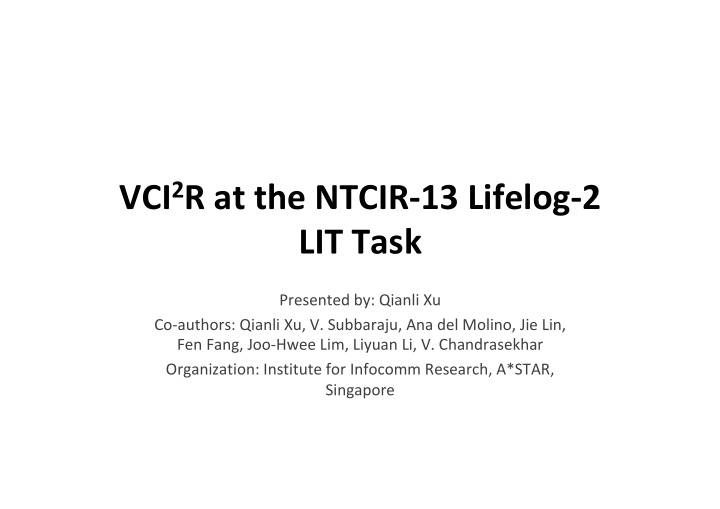



VCI 2 R at the NTCIR-13 Lifelog-2 LIT Task Presented by: Qianli Xu Co-authors: Qianli Xu, V. Subbaraju, Ana del Molino, Jie Lin, Fen Fang, Joo-Hwee Lim, Liyuan Li, V. Chandrasekhar Organization: Institute for Infocomm Research, A*STAR, Singapore
LIT Framework Retrieval Insight Mining Visualize Cluster Logging Ground truth Browse Data by Annotation Aggregate Search Features (Deep External Correlate Learning) Data Narrate Animate Activity Training Advise Annotation Compare (Retrieval) Training Images Feature weight Relevant concepts 120.0 4 110.2 w1 Time Spent in exercise (minutes) ImageNet1K 100.0 w2 Occurence (# of times) 3 w3 79.0 Places365 80.0 w4 w5 60.0 2 MSCOCO w6 40.0 w7 NTCIR 22.5 1 w8 20.0 3.8 w9 2.6 1.3 Time 0.0 0 w10 Run Hiking Gym/Yoga U1 (min) U2 (min) U1 (# of times) U2 (# of times) w11 # People w12 Location tag
Decoding the Topics and Retrieving Activities Topics Activities T1: Diet and blood sugar level Eating: user is eating food T2: Exercise & physical activity Walk, Run, Hiking*, Gym/Yoga. T3: Social User is facing one or more persons in a conversation T4: Transportation Driving a car or taking a taxi, taking a bus, taking a train, taking a plane T1: Diet/eating T2: Exercise T3: Social T4. Transport Retrieval 1. Extract semantics for all image frames: 1K objects, 365 places, 80 MS Process coco, meta-data (location, activity) 2. Define topics: semantics inclusion criteria 3. Prepare training and validation set from ground truth 4. Train parameters (linear regression) 5. Visual examination and fine-tuning (repeat steps 2~5)
Theme-finding & Insight Visualization Aggregate Cluster Associate Animate Compare (4) Affinity map (1) Bar chart (2) Clock-view (3) Bubble chart (8) Radar chart (5) Activity on geographical map (6) Sunburst chart (7) Calendar view
T1. Diet and Blood Sugar Level Diet log: Text Food type Food Diet Amount Eating Time
T1. Diet and Blood Sugar Level Nutritional information (Glycemic load) of frequent food & drink Drink Food
T1. Diet and Blood Sugar Level Factors contributing to blood sugar level • Food intake is the most important factor to BLU Exercise and sleep may help maintain lower blood sugar level, but not • statistically significant.
T2: Exercise & Physical Activity Temporal Pattern 120.0 4 110.2 Time Spent in exercise (minutes) 100.0 Occurence (# of times) 3 79.0 80.0 U1 60.0 2 40.0 1 22.5 20.0 3.8 2.6 1.3 0.0 0 Run Hiking Gym/Yoga U2 U1 (min) U2 (min) U1 (# of times) U2 (# of times) • Walking is the main mode of exercise; especially true for u1. U2 exercises more than U1. •
T3. Socialize Socializing vs. mood Geographic view Calendar view Socialize + exercise is good for mood
T4. Where Co-location of two • users inferred from GPS + time < 30 meters • Date: 2016.10.14 • Time: 19:00 • Place: • The Westin Dublin? Multiple view to • show the meeting of two users: map + photos
T4. Where The affinity map shows • places that are connected according to temporal and spatial dimensions. Each node represents a • place Each edge shows a • connection between them. A connection can be • specified according to the transportation mode (walk, car, bus, etc.) The map can be filtered • according to transportation mode.
T5: Compare U1 spent more time in commuting, eating and socializing, whereas u2 has more physical activity and enjoyed more sleep.
Prototype Mobile App • Themed diary presented in a mobile app. • Five themes are included according to the LIT task requirements. • Each theme features a list of items/questions of interest. • Insights are elaborated and visualized under each item. • On-line mode to be developed.
Summary • Data recording and processing • High quality data is always desirable • Accurate retrieval is key • Customization and personalization – Insights are highly individualized – Allow layman to generate their own insights • Insight interpretation • Allow layman users to understand • Scientific rigor vs. user experience • Interesting results facilitate UX but may sacrifice scientific rigor. Email: qxu@i2r.a-star.edu.sg
Recommend
More recommend